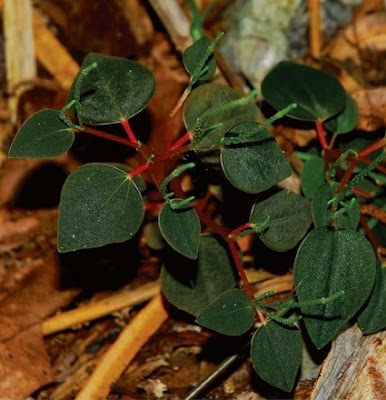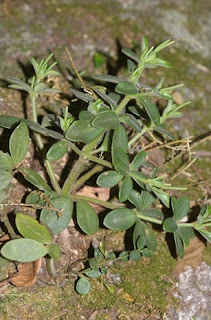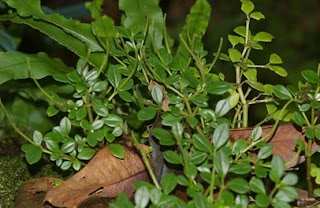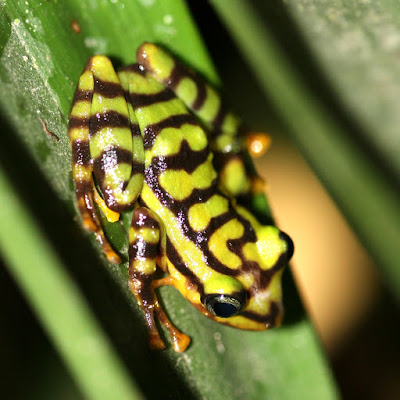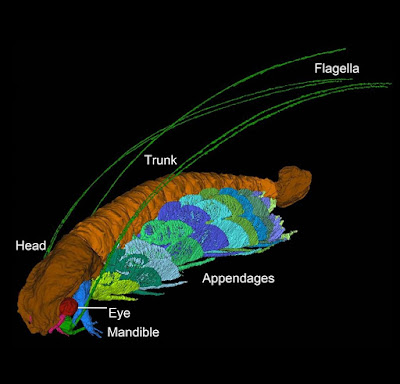[Most Recent Entries] [Calendar View]
Friday, March 24th, 2017
| Time | Event | ||||
| 2:04a | [Botany • 2017] New Species; Peperomia sirindhorniana รักตะนิล, P. heptaphylla, P. masuthoniana & P. multisurcula and A Reinstatement in Peperomia (Piperaceae) from Thailand
Summary Four new species of Peperomia (Piperaceae) from Thailand, namely Peperomia heptaphylla, Peperomia masuthoniana, Peperomia multisurcula and Peperomia sirindhorniana are described and illustrated. The reinstatement of Peperomia dindygulensis is also proposed with supporting morphological evidence. Key words: IUCN vulnerability; morphology; taxonomy Taxonomic Treatment • Peperomia heptaphylla Suwanph. & Hodk., sp. nov. Type: Thailand, Prachuap Kiri Khan Etymology. The specific epithet refers to the number of leaves per node. Vernacular Name: เบี้ยประจวบ - Bia Pra Chuap. • Peperomia masuthoniana Suwanph. & Chantar. sp. nov. Type: Thailand, Chiang Mai, Doi Chiangdao Etymology: The specific epithet honours Associate Prof. Sumon Masuthon (1952 – present), Department of Botany, Faculty of Science, Kasetsart University, who encouraged the first author to intensively study the family Piperaceae for the Flora of Thailand project. Vernacular Name: เบี้ยเชียงดาว - Bia Chiang Dao. • Peperomia multisurcula Suwanph. & Hodk. sp. nov. Type: Thailand, Nan Etymology: The specific epithet refers to the stems that have many clumps, and many main stems and branchlets. Vernacular Name: เบี้ยสะปัน - Bia Sa Pan (Nan). • Peperomia sirindhorniana Suwanph. & Chantar., sp. nov. Type: Thailand, Loei, Nong Hin, Pha Hin Ngam Conservation Status. This species is uncommon and only a few specimens have been collected from the border area between Loei and Khon Kaen provinces in northeastern Thailand. The populations are narrowly distributed in an area of karst limestone and not in a protected area. The populations are threatened by farming and deforestation. The status of Peperomia sirindhorniana is assessed as Critically Endangered (CR), according to IUCN (2011) criteria and the authors consider a category of B1b to be appropriate. Etymology: The specific epithet honours to H.R.H. Princess Maha Chakri Sirindhorn Mahidol who initiated the Plant Genetic Conservation Project to develop the personnel and plant genetics resources for the maintenance of plant varieties, and for the development to be advantageous for farmers and the business sector of Thailand. Vernacular Name: Rak-Ta-Nil. Notes: We discovered some unidentified specimens (T. Smitinand & H. Sleumer 1131 in BKF and L that were collected from Pha Nok Khao, Khon Kaen province, northeastern Thailand. They are similar to Peperomia pellucida in gross morphology but differ in some characters. We have subsequently collected living specimens from a nearby locality and they are easily recognised as a species new to science. The distinguishing characteristics of P. sirindhorniana are its red or reddish petioles and stems, and its bright to dark green leaves when fresh (subcoriaceous when dry) as opposed to pale green (membranous when dried) in P. pellucida. Furthermore, its fruits are larger than P. pellucida and are ovoid with a beaked apex formed from the style and it has densely acute papillae on the fruit surface.Reinstatement • Peperomia dindygulensis Miq. Etymology: The specific epithet refers to Dindygul (the city in the South Indian state of Tamil Nadu) from which the type specimens were collected. Vernacular Name: ผักป้องแดง - Phak Pong Daeng (Chanthaburi). Chalermpol Suwanphakdee, Trevor R. Hodkinson and Pranom Chantaranothai. 2017. New Species and A Reinstatement in Peperomia (Piperaceae) from Thailand. Kew Bulletin. 72(1); DOI: 10.1007/s12225-016-9662-5 รักตะนิล ซึ่งมีความหมายว่า เขียว-แดง เนื่องจากพืชชนิดนี้มีลำ ต้นและก้านใบสีแดง มีใบสีเขียวเข้มหรือสีมรกต | ||||
| 3:17a | [Herpetology • 2017] Pristimantis ecuadorensis • Diversification of the Rainfrog Pristimantis ornatissimus in the Lowlands and Andean Foothills of Ecuador
Abstract Geographic barriers and elevational gradients have long been recognized as important in species diversification. Here, we illustrate an example where both mechanisms have shaped the genetic structure of the Neotropical rainfrog, Pristimantis ornatissimus, which has also resulted in speciation. This species was thought to be a single evolutionary lineage distributed throughout the Ecuadorian Chocó and the adjacent foothills of the Andes. Based on recent sampling of P. ornatissimus sensu lato, we provide molecular and morphological evidence that support the validity of a new species, which we name Pristimantis ecuadorensis sp. nov. The sister species are elevational replacements of each other; the distribution of Pristimantis ornatissimus sensu stricto is limited to the Ecuadorian Chocó ecoregion (< 1100 m), whereas the new species has only been found at Andean localities between 1450–1480 m. Given the results of the Multiple Matrix Regression with Randomization analysis, the genetic difference between P. ecuadorensis and P. ornatissimus is not explained by geographic distance nor environment, although environmental variables at a finer scale need to be tested. Therefore this speciation event might be the byproduct of stochastic historic extinction of connected populations or biogeographic events caused by barriers to dispersal such as rivers. Within P. ornatissimus sensu stricto, morphological patterns and genetic structure seem to be related to geographic isolation (e.g., rivers). Finally, we provide an updated phylogeny for the genus, including the new species, as well as other Ecuadorian Pristimantis. Pristimantis ecuadorensis sp. nov. Guayasamin, Hutter, Tapia, Culebras, Peñafiel, Pyron, Morochz, Funk, Arteaga. Eleutherodactylus ornatissimus Lynch & Duellman 1997, in part. Pristimantis ornatissimus Arteaga, Bustamante & Guayasamin 2013, in part. Suggested common name in English: Ecuadorian Rainfrog Suggested common name in Spanish: Cutín de Ecuador Diagnosis: Pristimantis ecuadorensis is characterized by the following combination of characters: (1) skin on dorsum shagreen, that on venter smooth; discoidal fold defined posteriorly, (2) tympanic membrane and tympanic annulus evident, oval, (3) snout long, acuminate in dorsal view, rounded in profile, (4) upper eyelid lacking tubercles, (5) dentigerous process of the vomer present, bearing teeth, (6) males having vocal slits and Type I nuptial pads, (7) first finger shorter than second, (8) fingers with lateral fringes, (9) ulnar tubercles absent, (10) heel and tarsus lacking tubercles or folds, (11) inner metatarsal tubercle oval, 4–5x round outer metatarsal tubercle, (12) toes bearing lateral fringes; webbing absent; discs large; fifth toe much longer than third, (13) in life, greenish yellow dorsum with transversal black stripes that may form a reticulated pattern; iris light blue to grayish green or grayish yellow; in preservative, dorsum cream with black stripes, and (14) SVL in adult males 25.4 mm (n = 1) and 37.1–40.2 in adult females (n = 2). Distribution: Pristimantis ecuadorensis is known only from three nearby localities on the western slopes of the Ecuadorian Andes, provinces of Cotopaxi and Pichincha, at elevations between 1450–1480 m. The localities are: 3 km NE of San Francisco de Las Pampas, Palo Quemado, and Tandapi. With the information at hand, the distribution of P. ornatissimus sensu stricto is constrained to the Chocoan lowlands and Pacific Andean foothills (< 1100 m) of Ecuador. Natural History: Information for Pristimantis ecuadorensis is mainly available from the type locality (Fig 8), San Francisco de Las Pampas, a forested valley along the Río Toachi, located at 1480 m in the northwestern slopes of the Ecuadorian Andes. The locality has a mean annual precipitation of 2325 mm. In this area, P. ecuadorensis is found in primary forest and closely associated with the leaf axils of bromeliads, Heliconia plants and palm fronds (genera Ceroxylon and Wettinia) (field notes of Giovanni Onore, César Tapia, and W. E. Duellman). Additionally, the species is associated with banana (Musa paradisiaca) and sugar cane plantations (Saccharum officinarum) bordering native forest (Fig 9). In these ecosystems, P. ecuadorensis perch on top of leaves or inside leaf axils (~15–150 cm above the ground), creased leaves or moss of epiphytic plants, and have been heard calling from them. Additionally, by inspecting fecal samples, we found the remains of beetles, crickets and spiders. In captivity, females of P. ecuadorensis reach sexual maturity after 14 months, and males start vocalizing after 10 months. Etymology: The specific name ecuadorensis refers to the Republic of Ecuador, where the species is endemic. The name is intended to highlight the overwhelming beauty, and cultural and biological diversity of Ecuador.
Juan M. Guayasamin, Carl R. Hutter, Elicio E. Tapia, Jaime Culebras, Nicolás Peñafiel, R. Alexander Pyron, Carlos Morochz, W. Chris Funk and Alejandro Arteaga. 2017. Diversification of the Rainfrog Pristimantis ornatissimus in the Lowlands and Andean Foothills of Ecuador. PLoS ONE. 12(3): e0172615. DOI: 1371/journal.pone.0172615 ‘Spectacular-looking’ endangered frog species discovered in Ecuador’s cloud forests http://source.colostate.edu/spectacular-l | ||||
| 9:58a | [Paleontology • 2017] Cascolus ravitis • A New Crustacean from the Herefordshire (Silurian) Lagerstätte, UK, and Its Significance in Malacostracan Evolution
Abstract Cascolus ravitis gen. et sp. nov. is a three-dimensionally preserved fossil crustacean with soft parts from the Herefordshire (Silurian) Lagerstätte, UK. It is characterized by a head with a head shield and five limb pairs, and a thorax (pereon) with nine appendage-bearing segments followed by an apodous abdomen (pleon). All the appendages except the first are biramous and have a gnathobase. The post-mandibular appendages are similar one to another, and bear petal-shaped epipods that probably functioned as a part of the respiratory–circulatory system. Cladistic analysis resolves the new taxon as a stem-group leptostracan (Malacostraca). This well-preserved arthropod provides novel insights into the evolution of appendage morphology, tagmosis and the possible respiratory–circulatory physiology of a basal malacostracan. Systematic palaeontology Phylum Arthropoda Subphylum Crustacea Class Malacostraca Subclass Phyllocarida Order Leptostraca Genus Cascolus gen. nov. Type species: Cascolus ravitis sp. nov. Etymology: The new crustacean is named in honour of the naturalist and broadcaster Sir David Attenborough, who grew up on University College Leicester campus, in celebration of his 90th birthday. Latin castrum ‘stronghold’ and colus ‘dwelling in’; alluding to the Middle/Old English source for the surname ‘Attenborough, derived from atten ‘at the’ and burgh ‘a fortified place’. Latin Ratae, the Roman name for Leicester, vita ‘life’ and commeatis ‘a messenger’. Diagnosis of genus (monotypic) and species: An elongate body comprising a head with a head shield, pedunculate eyes and five limb pairs; and a trunk consisting of a thorax (pereon) with nine limb-bearing segments and an apodous abdomen (pleon). The first appendage is uniramous and has three slender flagella longer than the body. All other appendages are biramous and have a gnathobase. The post-mandibular appendages are similar to one another, except that the fourth head appendage bears a single petal-shaped epipod, and the fifth head appendage and each trunk appendage bear two petal-shaped epipods. Material: Only known from the holotype OUMNH C.29698 (figure 1v), a specimen with soft parts reconstructed in three dimensions (figure 1a–u). Locality and horizon: Herefordshire, England, UK; Wenlock Series, Silurian. David J. Siveter, Derek E. G. Briggs, Derek J. Siveter, Mark D. Sutton and David Legg. 2017. A New Crustacean from the Herefordshire (Silurian) Lagerstätte, UK, and Its Significance in Malacostracan Evolution. Proceedings of the Royal Society B. DOI: 10.1098/rspb.2017.0279 430 million-year-old fossil named in honor of Sir David Attenborough http://phy.so/409322871 @physorg_com | ||||
| 4:52p | [Botany • 2017] Begonia tenasserimensis | ส้มกุ้งตะนาวศรี • A New Species of Begonia section Parvibegonia (Begoniaceae) from Thailand and Myanmar
Abstract Begonia tenasserimensis sp. nov. belongs to Begonia sect. Parvibegonia and is endemic to the hills of the Tenasserim Range, based on specimens from Peninsular Thailand and Tenasserim Division in Myanmar. The species is restricted to karst limestone and has been assessed as Vulnerable according to IUCN criteria. Keywords: Southeast Asia; limestone; taxonomy 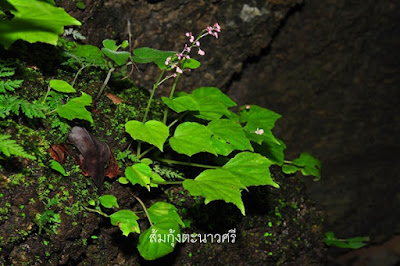 Begonia tenasserimensis Phutthai & M. Hughes, sp. nov. Begonia tenasserimensis is vegetatively similar to and shares the presence of persistent tepals when the fruit matures with B. crenata Dryand., but differs from that species in having an acutely lobed leaf lamina with 3 main veins (vs unlobed with 5 main veins) and a shortly spinose dentate leaf margin (vs crenate), pistillate flowers with 5 tepals (vs 6) and staminate flowers with lanceolate inner tepals (vs broadly elliptic), and a more branched inflorescence. Etymology. The specific epithet ‘tenasserimensis’ is derived from the Tenasserim Range to where the species is endemic. T. Phutthai and M. Hughes. 2017. A New Species of Begonia section Parvibegonia (Begoniaceae) from Thailand and Myanmar. Blumea - Biodiversity, Evolution and Biogeography of Plants. DOI: 10.3767/000651917X695083 ส้มกุ้งตะนาวศรี Begonia tenasserimensis Phutthai & M. Hughes พบในเขตจังหวัดระนอง สตูล และเขตเทือกเขาตะนาวศรี สาธารณรัฐแห่งสหภาพเมียนมา เป็นพืชถิ่นเดียวของไทยและเมียนมา สถานภาพเสี่ยงต่อการสูญพันธุ์ |
| << Previous Day |
2017/03/24 [Calendar] |
Next Day >> |
